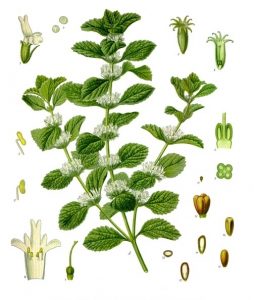
Medicinal pemethrum – Marrubium vulgare
Description of medical pemete grass:
Marrubium vulgare (Old or other known names: white pemete, pansy, peszerce, pansy, pemetum) Medical marjoram is a perennial plant with a persistent underground stem that sends up annual green shoots above the ground. Stems branched 25-60 cm tall, four-edged, white moth-like. The leaves are transverse, short-tongued or sessile, rounded ovate, with a wrinkled surface and serrate margins; the backs are greyish or whitishly felted. The white hairs on the stem, the lower leaf blade and the white hairs on the flowers around the flowers are what herbalists call the white pemetis marrubium album. The flowers are in the axils of the upper leaves, in dense circles called whorls. The flower has a greenish tubular calyx with a ten-toothed edge, the teeth alternately larger and smaller, hooked back when the seed ripens. Inside the calyx is the white-coloured pistil, which is tubular at the bottom and has two lips at the top. In the tube of the cushion are 4 stamens, two longer and two shorter. Inside is the pistil, which separates into 4 ovoid acorns. At flowering, the pistil and the stamens fall off, but the calyx remains, containing the 4 acorns. The pistil flowers from July to September.
Occurrence:
The pemete grows in dry places, near towns and villages, along roads and fences, in fallow land, railway embankments and pastures. It occurs throughout the country, but not in very large numbers, and is rare in the northern part of the country, e.g. in the county of Spiš, and absent in the northern part of Transylvania.
Pemete grass medicinal properties, uses:
When freshly rubbed, the pemete has a pleasant, balsamic scent with a slightly musky odour. The taste is succulent, bitter, slightly pungent. The flowering shoots are sweet, pungent and pungent with a pungent, pungent, pungent taste people’s anti-pneumonia tea use as a dry plant. Pemethrum is used for chronic wasting, atrophy, cirrhosis and jaundice, although it is not mentioned in the official pharmacopoeia. Its flowering shoots are also known as herba marrubii and herba marubii albi. They contain a bitter substance called marrubin.
Active ingredient:
Marrubin, essential oil and tannic acid.
Cultivation:
The plant, which is not fussy about soil, is cultivated by sowing seeds or by division in the months of March or October. The plant requires 40 x 50 cm of space. To plant one cat. acre, 250 grams of seed or 30,000 seedlings are required, yielding 10-12 q leaf stems. As a honey producer, its cultivation is particularly useful for beekeepers, as it provides food for bees at a time when the honeysuckle is in short supply.
Harvesting:
Pemete should be harvested before flowering. Harvesting should only be done while the stems are still tender, when the stems are 15 to 20 cm high and when they are in flower, they are no longer marketable. The leaves can be picked from April onwards, but care must be taken not to mix them with other plants with similar flowers. Young plants are cut from the stems, cleaned of sand, soil and possibly the roots and dried slowly in an airy attic. The well-dried seedlings are transported in a bag 6-7 kg of fresh plants will produce 1 kg of dry goods, which is valuable if it is a nice green colour. (Plants flowering between June and July are dried after the above-ground part has been collected, spread out in a palm-thick layer in a ventilated attic. According to Dr Ferenc Darvas) Occurrence Medicinal properties Active ingredient Collection Cultivation Source: Dr. Ferenc Darvas and Dr Gyula Magyary-Kossa,Domestic herbs, their production, marketing, effects and medicinal uses Béla Páter, Wild medicinal plants, their production, use, distribution, and marketing
